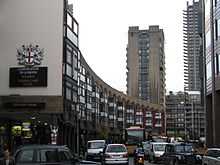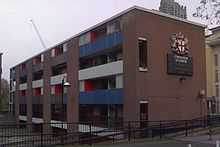Golden Lane Estate
Coordinates: 51°31′20″N 0°05′44″W / 51.5223°N 0.0956°W


The Golden Lane Estate is a 1950s council housing complex in the City of London. It was built on the northern edge of the City, in an area devastated by bombing during World War II.
Origins

The idea to build a residential site to the north of the Cripplegate area, followed devastation of much of the City of London in the Blitz during World War II. Following almost complete destruction in the Blitz, only around 500 residents remained in the City in 1950, a mere 50 of whom lived in Cripplegate. The brief was to provide general needs council housing for the many people who serviced or worked in the City, as part of the comprehensive recovery and re-building strategy of the City of London.
As the Estate then fell within the boundary of the Metropolitan Borough of Finsbury, a proportionate number of tenancies were also offered to those on the Finsbury waiting list. A boundary change in 1994 means the estate is today wholly inside the City of London.
Compared to other council housing of the era, there was a greater emphasis on the housing needs of single people and couples rather than larger families. Studios and one bedroomed flats comprise the majority (359) of the units (554 in total). The density at 200 person per acre was high, but 60% of the area of the site is open space, a figure made possible by building taller structures than was common in 1951.
The site had been occupied since the mid 19th century by small Victorian industries and businesses, especially metal working. Some of the basements of the bombed buildings were retained as sunken areas of the landscaping.It was designed by architects Chamberlin, Powell and Bon, who later designed the adjacent, Barbican Estate.[1] The estate was commissioned and paid for by the City of London, who still own the freehold and act as managers, and the area was transferred to the City of London in 1994, following boundary changes lobbied for by residents.[2] However, it is distinguished from the bulk of the City of London, which is today the largely non-residential European financial services capital.
The first phase of the estate was officially opened in 1957, developed around the moved Jewin Welsh Presbyterian Chapel. Before completion, the estate was enlarged to the West as more land was acquired, with three buildings added later: Cullum Welch House and Hatfield House and Crescent House. This last was completed in 1962. The competition for designs was announced in 1951, and at a time when post WW II recovery was still slow, the opportunity to design such an estate attracted a lot of interest among architects. The competition and entries to it were covered in the architectural and popular press. Golden Lane Estate is important as the first work of the partnership
Golden Lane competition
Formed when Geoffry Powell won the competition to build the estate on 26 February 1952.[3] The three partners-to-be of Chamberlin, Powell and Bon were all lecturers in architecture Kingston School of Art and had entered into an agreement that if any one of them won, they would share the commission. The competition was assessed by Donald McMorran, who also designed (in conservative style) housing for the Corporation of London. Alison and Peter Smithson were among the dozens of entrants to the competition, and though not even runners-up in the competition they publicised their unsuccessful entry energetically in the press.
Architecture

The maisonette blocks are faced with panels in primary colours (red and blue on maisonette blocks and yellow on the tower block). There is less use of unfaced concrete than in the Barbican. However, some of the concrete surfaces which are today painted were originally unpainted as they suffered early on from staining and streaking from iron pyrites in the aggregate.
Inside, most maisonettes display open tread terrazzo staircases projecting from the party walls as a cantilever. This, and the fact that the bedrooms are suspended, structurally speaking, without supports over the living rooms gives very compact planning with a surprisingly spacious feel to small flats, in spite of the fact that they were built under severe Government building restrictions of the post WW II years. The engineer was Felix Samuely. Some maisonettes retain their hour-glass shaped hot-water radiators, visible in windows.
Crescent House, the last of the blocks to be completed in 1962 and the largest, runs along Goswell Road. Designed by the firm's assistant architect and draughtsman Michael Neylan, it shows a tougher aesthetic that the architects were developing at the adjacent Barbican scheme, the early phases of which were by then on site.
The architects kept to their brief of providing the high density within the 7 acres (2.8 ha) available. The visual anchor of the design is the tower block of one-bedroomed flats, Great Arthur House, which provides a vertical emphasis at the centre of the development and, at 16 storeys, was on completion briefly the tallest residential building in Britain. It was the first residential tower block in London that was over 50 metres in height, and also the first building to breach the 100 foot height limit in the City of London.[4]
Roof garden
The roof garden of Great Arthur House has fabulous views of St Pauls Cathedral, the Barbican Estate and over North London. It extends to three stories high, making a virtue out of the lift winding gear and tank housing. It makes the most of the small footprint of this tower block. Pergolas and carefully integrated window cleaning equipment are treated for their sculptural qualities. An ornamental pool with stepping stones reflects on spring and Autumn morning ripples from the water to the underside of the extravagant curved concrete canopy. It was originally open to all residents of the estate as recreational space - which is at a premium on this dense urban site. The roof garden has sadly been closed for more than a decade for health and safety reasons.
A model for social housing and urban living

When completed the estate attracted even more publicity than the architectural competition, being viewed as a symbol of post-war recovery. It was widely photographed and written about, also featuring in various newsreel features. From the outset the estate was also regarded as a model of social integration with early tenants including caretakers, clergymen, clerks, doctors, office cleaners, police officers and secretaries.
Today the estate is home to approximately 1,500 people living in 559 one, two or three bedroom units. There are 385 flats and 174 maisonettes. By 2015 51% of the flats had been sold on long leases under the Right to buy scheme provisions brought in by the Thatcher government and, when subsequently sold into the commercial market, leases have proved attractive to design-conscious buyers and command good prices. The rental flats continue as council housing let at affordable rents. Applications for rented housing units can be made to the City of London for eligible applicants who live or work in the City of London. On the western edge of the estate is a line of shops, and there are social facilities open to all residents, a public swimming pool and gym, police office, estate office, nursery, pub and tennis courts (originally a bowling green) - the whole combining to make an urban microcosm. A number of these facilities survive in their original uses, preserving the values that lay behind the creation of the estate. Once common in post-WW II local authority planning and housing, this idealism, commitment to quality design and a holistic vision of urban living have in many cases been abandoned by municipalities.
John Robertson Architects was selected by tender to restore Great Arthur House, dating from 1959. The project includes external redecorations, the replacement of the curtain wall system with a near facsimile to higher thermal performance and concrete repairs.[5]
Corbusian influences
Both the earlier work and that at Crescent House are clearly influenced by the work of Le Corbusier, an influence the architects were happy to acknowledge. Crescent House displays affinities with his Maisons Jaoul at Neuilly-sur-Seine while the maisonettes (with their open plan stairs and double-height stair spaces) are reminiscent of those at his Unité d'Habitation in Marseilles and elsewhere. The idea of an estate as urban microcosm is itself clearly traceable to the thinking of Le Corbusier, evidenced by the Unités and elsewhere. The detailing and finishes of the Golden Lane Estate do, however, differ substantially to those of Le Corbusier's work.
Listed building status
As of 1997, the estate comprises Listed buildings of Special architectural interest. Much of the estate is listed at Grade II,[6][7][8] with the exception of Crescent House, which received a Grade II* listing in view of its importance as an example of post-war residential architecture.[9] The estate has remained largely intact, despite undergoing a steady erosion of design detail. In 2006/2007, in part to address this erosion, Listed Building Management Guidelines were developed with Avanti Architects and a panel of residents and stakeholders to ensure the continued maintenance of the property. Though listing restricts owners' freedom to make lasting modifications to their individual flats (under threat of criminal prosecution), values on the estate have followed others in the area in rising steadily since listing.
References
- ↑ Modern Architecture London
- ↑ Golden Lane - Listed Building Management Guidelines
- ↑ http://www.britishlistedbuildings.co.uk/en-466569-great-arthur-house-including-boiler-hous
- ↑ http://www.skyscrapernews.com/buildings.php?id=2391
- ↑ http://www.colorcoat-online.com/blog/index.php/2012/08/original-london-tower-block-to-get-makeover/
- ↑ English Heritage
- ↑ English Heritage
- ↑ English Heritage
- ↑ English Heritage
Nearby rail and Tube
- Liverpool Street station
- Barbican tube station
- Moorgate station
- Farringdon station
- Old Street station
External links
| Wikimedia Commons has media related to Golden Lane Estate. |